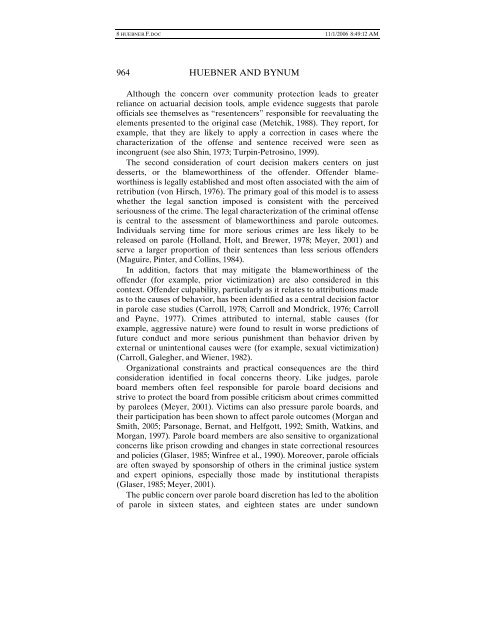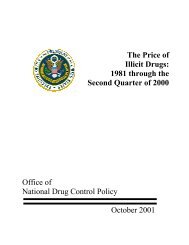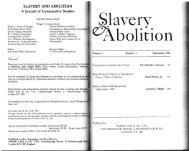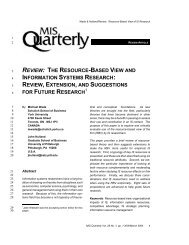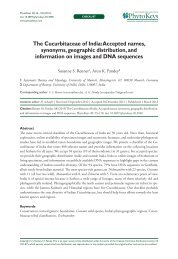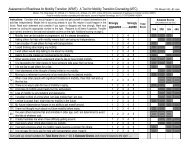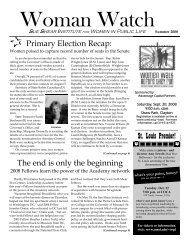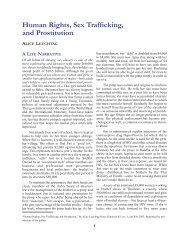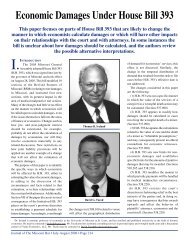an analysis of parole decision making using a sample of sex offenders
an analysis of parole decision making using a sample of sex offenders
an analysis of parole decision making using a sample of sex offenders
Create successful ePaper yourself
Turn your PDF publications into a flip-book with our unique Google optimized e-Paper software.
8 HUEBNER F.DOC 11/1/2006 8:49:12 AM<br />
964 HUEBNER AND BYNUM<br />
Although the concern over community protection leads to greater<br />
reli<strong>an</strong>ce on actuarial <strong>decision</strong> tools, ample evidence suggests that <strong>parole</strong><br />
<strong>of</strong>ficials see themselves as “resentencers” responsible for reevaluating the<br />
elements presented to the original case (Metchik, 1988). They report, for<br />
example, that they are likely to apply a correction in cases where the<br />
characterization <strong>of</strong> the <strong>of</strong>fense <strong>an</strong>d sentence received were seen as<br />
incongruent (see also Shin, 1973; Turpin-Petrosino, 1999).<br />
The second consideration <strong>of</strong> court <strong>decision</strong> makers centers on just<br />
desserts, or the blameworthiness <strong>of</strong> the <strong>of</strong>fender. Offender blameworthiness<br />
is legally established <strong>an</strong>d most <strong>of</strong>ten associated with the aim <strong>of</strong><br />
retribution (von Hirsch, 1976). The primary goal <strong>of</strong> this model is to assess<br />
whether the legal s<strong>an</strong>ction imposed is consistent with the perceived<br />
seriousness <strong>of</strong> the crime. The legal characterization <strong>of</strong> the criminal <strong>of</strong>fense<br />
is central to the assessment <strong>of</strong> blameworthiness <strong>an</strong>d <strong>parole</strong> outcomes.<br />
Individuals serving time for more serious crimes are less likely to be<br />
released on <strong>parole</strong> (Holl<strong>an</strong>d, Holt, <strong>an</strong>d Brewer, 1978; Meyer, 2001) <strong>an</strong>d<br />
serve a larger proportion <strong>of</strong> their sentences th<strong>an</strong> less serious <strong>of</strong>fenders<br />
(Maguire, Pinter, <strong>an</strong>d Collins, 1984).<br />
In addition, factors that may mitigate the blameworthiness <strong>of</strong> the<br />
<strong>of</strong>fender (for example, prior victimization) are also considered in this<br />
context. Offender culpability, particularly as it relates to attributions made<br />
as to the causes <strong>of</strong> behavior, has been identified as a central <strong>decision</strong> factor<br />
in <strong>parole</strong> case studies (Carroll, 1978; Carroll <strong>an</strong>d Mondrick, 1976; Carroll<br />
<strong>an</strong>d Payne, 1977). Crimes attributed to internal, stable causes (for<br />
example, aggressive nature) were found to result in worse predictions <strong>of</strong><br />
future conduct <strong>an</strong>d more serious punishment th<strong>an</strong> behavior driven by<br />
external or unintentional causes were (for example, <strong>sex</strong>ual victimization)<br />
(Carroll, Galegher, <strong>an</strong>d Wiener, 1982).<br />
Org<strong>an</strong>izational constraints <strong>an</strong>d practical consequences are the third<br />
consideration identified in focal concerns theory. Like judges, <strong>parole</strong><br />
board members <strong>of</strong>ten feel responsible for <strong>parole</strong> board <strong>decision</strong>s <strong>an</strong>d<br />
strive to protect the board from possible criticism about crimes committed<br />
by <strong>parole</strong>es (Meyer, 2001). Victims c<strong>an</strong> also pressure <strong>parole</strong> boards, <strong>an</strong>d<br />
their participation has been shown to affect <strong>parole</strong> outcomes (Morg<strong>an</strong> <strong>an</strong>d<br />
Smith, 2005; Parsonage, Bernat, <strong>an</strong>d Helfgott, 1992; Smith, Watkins, <strong>an</strong>d<br />
Morg<strong>an</strong>, 1997). Parole board members are also sensitive to org<strong>an</strong>izational<br />
concerns like prison crowding <strong>an</strong>d ch<strong>an</strong>ges in state correctional resources<br />
<strong>an</strong>d policies (Glaser, 1985; Winfree et al., 1990). Moreover, <strong>parole</strong> <strong>of</strong>ficials<br />
are <strong>of</strong>ten swayed by sponsorship <strong>of</strong> others in the criminal justice system<br />
<strong>an</strong>d expert opinions, especially those made by institutional therapists<br />
(Glaser, 1985; Meyer, 2001).<br />
The public concern over <strong>parole</strong> board discretion has led to the abolition<br />
<strong>of</strong> <strong>parole</strong> in sixteen states, <strong>an</strong>d eighteen states are under sundown


